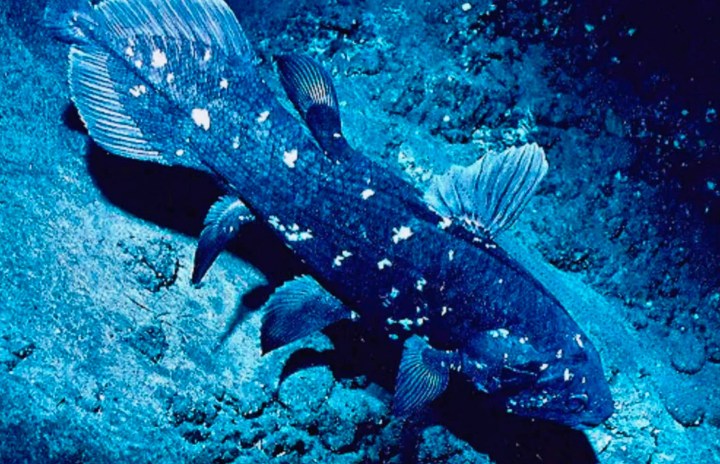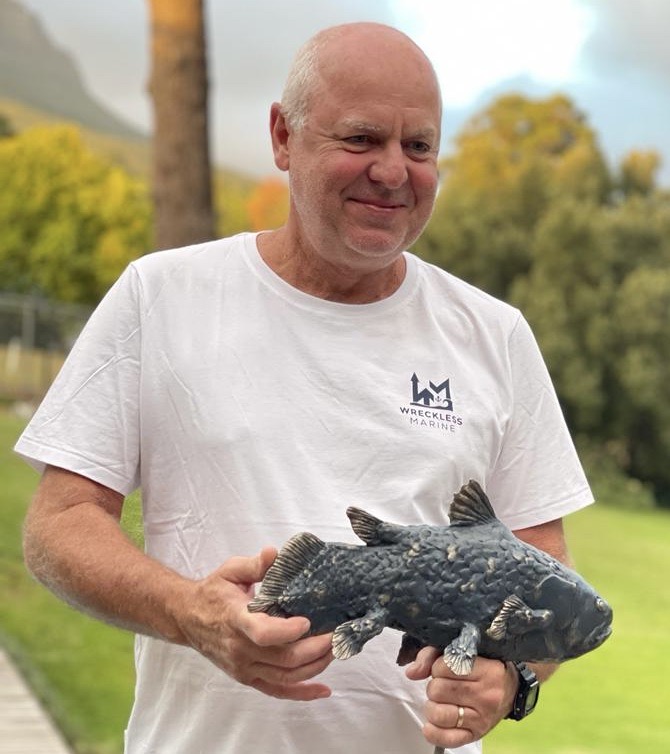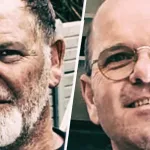A DEEP DIVE
South Africa’s underwater explorers are going deeper to map biodiversity and track climate change in the ocean

Over 75% of the ocean remains unmapped despite the importance of seabed mapping to sustainable management of ocean biodiversity and marine conservation in the face of the climate crisis. But South African underwater explorers are making waves and making maps that could change what we know about our oceans.
The story of the Coelacanth is a story of discovery. Once considered to have gone extinct approximately 65 million years ago when dinosaurs last roamed the earth, the 1938 discovery of a specimen hauled in by fishermen off the coast of South Africa was unprecedented.
The Coelacanth first discovered 83 years ago in East London was a miraculous find, but it was not until many years later, in 1987 that the first live specimen was observed in the waters of the Comoro Islands.
It was this discovery of the living fossil that sparked the interest of Bruce Henderson, who had been living at sea with his wife and had spent many months in the Comoros at the time.
“So I had always had this ambition to dive with Coelacanth but we hadn’t dived deep enough to see any,” says Henderson.
“Then they were found in South Africa in 2001 and a Coelacanth was first spotted at Sodwana Bay at a depth of about 100 meters,” explains Henderson.
With renewed hope and a known population in the Jesser Canyon, Henderson began to plan his 2019 expedition.

Bruce Henderson is the founder of Wreckless Marine, an underwater exploration outfit that aims to further the knowledge of what lies below the sea. (Photo: Supplied)
Of the first water
“But we couldn’t get permits,” says Henderson. Having booked time off work, flights and accommodation, at the 11th hour all hopes were dashed.
“So I called up an old mate and I said ‘look, my Sodwana trip is off, I am going to come and join you guys’,” says Henderson.
It was Mike Frazer and his son, Alan Frazer that had suggested the group dive the Umzumbe Canyon on the south coast of Kwazulu-Natal where Alan had fished in the past.
“He had said in certain conditions, during cold water upwellings, they get these weird deep water fish that they couldn’t explain,” says Henderson.
Alan speculated that it was untrue that Coelacanth could only be found in Sodwana and not in other areas down the coast as had originally been thought, says Henderson.
“So we dived there, not really thinking we would find Coelacanth,” says Henderson.
But it was only 10 minutes into the dive at a depth of 69 metres that they discovered and filmed a live Coelacanth.
“We swam straight into this great, big, two-metre Coelacanth and it was just absolutely mind-blowing,” says Henderson.
“It was quite confusing, at that depth you are not thinking clearly and you kind of just think, ‘but my Coelacanth trip hasn’t happened yet, why am I looking at this fish?’” explains Henderson.
“We were able to record it and it was quite exciting for the scientists because it was the first time Coelacanth had been seen further south since it had first been discovered in East London all those years ago,” says Henderson.
It was originally speculated that the 1938 Coelacanth was a stray and that it had been washed down by the current, “but we started to think maybe not, maybe there is a population that far south after all,” says Henderson.
“We were about halfway there and we’ve spotted more since going. I am quite excited to explore further down the coast to East London and see if we can find a population there from which the original Coelacanth would have come.”
Wreckless Marine
Henderson is the founder of the ocean exploration team, Wreckless Marine and their 2019 discovery of Coelacanth is just one of the many contributions that they have been able to make to understanding biodiversity in South Africa’s marine ecosystems.
“As much as the scientists know an enormous amount about the oceans, there is this vast space there that we actually know very little about,” says Henderson.
“We are not an entity on a mission or crusade,” says Henderson. But through mapping and diving South Africa’s coastlines the Wreckless Marine team has been able to collect meaningful data and aid in biodiversity and habitat mapping to help scientists understand the health of the country’s ocean ecosystems.
“We have been really lucky in certain instances, like when we bumped into a Coelacanth,” says Henderson, “but there are a lot of examples like that that are less dramatic.
Visit Daily Maverick’s home page for more news, analysis and investigations
“Collecting kelp samples is not as exciting as finding Coelacanth but it’s really important for the scientists to map biodiversity, to accurately build on the baseline knowledge for us to monitor conservation efforts or on the contrary the impacts of commercial activity at sea,” says Henderson.
Wreckless Marine uses mapping technology to discover new reefs to dive and document all their underwater exploration.
Mapping for marine conservation
Mapping and exploration work in our oceans is crucial and Wreckless Marine actively contributes all the data they collect to South African National Biodiversity Institute (Sanbi), University of Cape Town researchers and the Nippon Foundation-Gebco Seabed 2030 project, which aims to produce a complete map of the ocean floor by 2030.
Mapping our seabed could be beneficial in a number of areas from climate change research, tracking biodiversity and managing ocean resources.
“You can’t manage what you don’t measure and we have yet to measure over 76% of the world’s oceans,” says David Millar, America’s Government Accounts Director for Fugro in a recent Webinar.
“We need to drastically improve our understanding of the ocean,” says Millar.
“Wreckless Marine are one of the citizen scientists contributing information about the species seen in the deeper parts of South Africa’s oceans,” says Kerry Sink, Principal Scientist and Manager of the Sanbi’s Marine Programme.
“And the deeper that you go the less information there is and the more important it is,” she adds.
“To effectively manage biodiversity we have to know what we are managing and what the sensitivities are for those ecosystems,” says Sink. Sanbi uses information gathered to contribute to a national map of the marine ecosystem types.
“At the moment, South Africa has 163 different ecosystem types in our mainland ocean territory and what is really important is that we have a map and we understand the sensitivities of those different ecosystem types,” says Sink.
“There are even underwater animal forests made up of animals like sea fans and sea whips and sea pens,” says Sink. These very curious creatures are very sensitive to any activity on the seabed, so anchors, mining and trawling can all affect the health of this marine ecosystem.
Watch on Daily Maverick: Multibean Survey
Many of the deepwater ecosystem types like animal forests, cold-water coral reefs and submarine canyons are sensitive to certain commercial activities but cannot be protected from those activities if scientists do not know where they are.
“So you want to know where the more sensitive areas are so that you can manage them,” says Sink. Being able to find and assess the state of these marine ecosystems, the risks that they are exposed to and to be able to track their health will aid work to expand Marine Protected Areas in the country.
“Just like we protect areas of forest, Fynbos and desert on land, in the sea we need to represent and protect the different ecosystem types,” says Sink.
With so little knowledge on the true state of ocean biodiversity, discoveries like the Coelacanth further south on South Africa’s coast exemplify the need to explore the oceans.
Fluctuations in biodiversity can help scientists understand the climate crisis but “if you don’t know what you have you will never be able to track change, so understanding climate change in the ocean is important but can only really be accomplished if we know what we already have,” says Sink.
“There is so much to be learned and what we find can be so significant on the Earth and humankind because we know so little about the ocean,” says Henderson.
“Marine ecosystems have such a big impact on climate and understanding what happens at sea helps us truly understand the broader health of the planet,” he adds. DM/OBP






















Comments - Please login in order to comment.